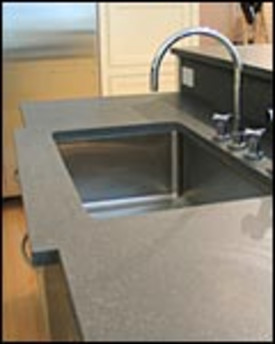 Stone counters are elegant and durable when installed and cared for properly. |
Stone Properties
When it comes to selecting countertops, stones with similar looks and characteristics are often combined into one class, even though they may actually be different stone types. The most common stone types for kitchen countertops are marble, slate, soapstone, limestone, travertine, and some sandstones. Slabs are cut into two-foot wide strips and then further custom fabricated.
A stone’s strengths and vulnerabilities depend on its hardness or resistance to abrasion and scratching. Stones are composed of deposits that affect their overall strength. Granite—composed of quartz and feldspars—is resistant to scratches and resistant to many chemicals. Marble—any crystallized carbonate rock—is softer and more chemically sensitive, so it will show wear sooner than granite. Marble can be etched by acids and stained by oils, but is restored more easily than granite.
Stones like marble that are limestone-based are more susceptible to acid attacks than silicate-based stones like slate, soapstone, or granite. Stone counters are susceptible to stains, scratching, and breaking, but are easy-to-clean and resistant to bacteria growth. Stone countertops are cleaned with hot water, not detergent because it can leave a cloudy residue. Granite tops may be wiped with vinegar.
Preventing Countertop Damage
Understanding a stone countertop’s vulnerabilities and care requirements will ensure a comfortable and long-lasting fit in your home.
Staining
Most, but not all, stone countertops come sealed with a substance that impregnates the material to protect against stains. If a sealer or impregnator is applied, be sure that it is non-toxic and safe for use on food preparation surfaces. Stone countertops that are sealed usually require re-application every five years, and sometimes as often as every two years depending on the product used.
"The biggest issue on any contaminant is dwell time," says Chuck Muehlbauer, technical director for the Marble Institute of America, in Westlake, Ohio. If you choose a stone countertop, you will have to protect it—as you would most other types of countertops—from staining foods by cleaning up immediately after use or a spill. Acids from tomatoes or lemon juice are noted for staining if not wiped up promptly.
Scratches
Guard against scrapes from pans or knives on marble or other non-granite stone surfaces by using placemats under china, ceramics, silver, and abrasive objects that can scratch the surface.
|
Cracking
Stone—even granite—can crack from a strong, localized heat source such as hot pans or dishes, so it’s important to use trivets or hot mats underneath.
Repairing Stone Counters
Counters can be polished to eliminate stains or scratches. Small cracks or chips may require resin injection and polishing, a job best left to professional restorers. Pitting is common with granite and most polished igneous rocks so you must be prepared for how the stone will age. Fissures also occur naturally in many stone types. This visible separation differs from a crack in that it is a naturally occurring feature in the stone and one that contributes to its character.
If your stone surface cracks, the entire countertop will need to be replaced. However, certain repairs are possible if the damage is not in a structurally significant area.
Costs and Installation
Once a stone is cut into strips, the fabricator uses basic measurements of your countertop to finish edges and plan for sink and cooktop cutouts. Stone countertops range from $30 to $100 per square foot installed. The type of stone, thickness, and number of cutouts impacts the cost. Almost all stone countertops come in either 20mm or 30mm thicknesses, roughly 3⁄4 and 11⁄4 inches. Dozens of edge profiles are available.
A very experienced handyman could install a stone countertop, but it’s not recommended by stone experts. A fabricated countertop often arrives in sections that must be seamed. Separate stone backsplashes, corners, and extra long sections require seaming. Multiple sections will not affect performance but will impact installation and total cost.
During installation, cabinets must be permanently affixed. Fragile stone varieties or those with excessive fissuring or unsound veins may require a full subtop to support the stone. If an undermount sink has been chosen, a special support rail for the cabinet frame is suggested. Stone sections are set on adhesive beads on the cabinet. Polyester adhesive, which cures to a hard shiny state, is the most common material used to seal the seams, which are about 1/16th of an inch. The whole installation process typically takes a half day.
Credit: Renovate Your World





























